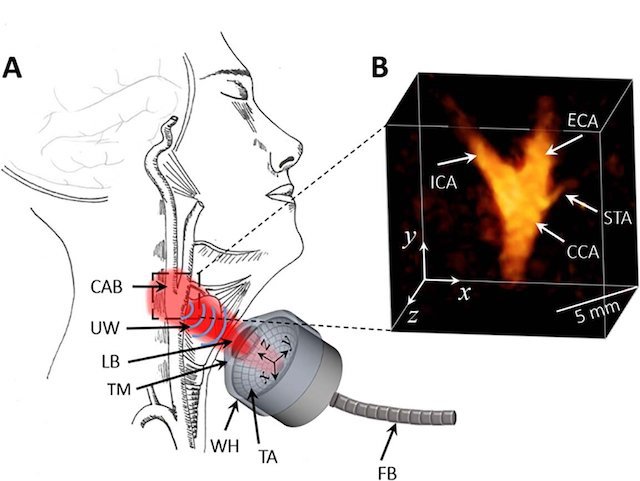
In a new study, researchers developed a new noninvasive technique for imaging the carotid artery.
It offers advantages over other imaging methods and could provide an earlier, more accurate assessment of cardiovascular disease risk.
The carotid arteries are the blood vessels located on the left and right side of the neck that bring oxygenated blood to the head.
Each artery bifurcates, or forks, in the neck into two branches that form the internal and external carotid arteries.
Most ischemic strokes, or strokes related to a build-up of plaque in the arteries, are associated with carotid artery disease originating from the area where the arteries bifurcate.
Imaging techniques like ultrasound, CT and MRI are useful for revealing the extent of narrowing in the carotid arteries, but less helpful in determining the makeup of the plaque itself.
This is a crucial limitation because plaque composition is associated with vulnerability to rupture, setting in motion the chain of events that leads to life-threatening strokes.
In the study, the team examined a new technique for carotid artery assessment called volumetric multi-spectral optoacoustic tomography (vMSOT).
As with ultrasound, vMSOT is performed with a handheld device that is moved against the neck.
However, vMSOT employs the science of spectroscopy to investigate tissue at a molecular scale. This provides information about the artery that is not attainable with other methods.
It also can detect lipids, the pigment melanin and other disease-related biomarkers early enough to provide better treatment options.
The researchers performed vMSOT imaging on 16 healthy participants and compared results with those from conventional ultrasound.
The vMSOT approach was able to noninvasively and instantaneously assess the entire bifurcation area of the carotid artery in three dimensions, thus making it less prone than ultrasound to motion-related, image-blurring artifacts.
Researchers said the results point to the tremendous potential of the new approach in the clinic.
The developed handheld vMSOT imaging approach holds promise for rapid volumetric assessment of the carotid artery and plaque vulnerability in an entirely noninvasive manner.
It also has the additional potential for label-free identification and assessment of clinically-relevant biomarkers of carotid artery disease, which helps with early and accurate diagnosis, timely treatment planning and monitoring.
In the future, vMSOT could be combined with ultrasound for a more comprehensive characterization of the carotid artery.
The study senior author is Daniel Razansky, Ph.D., director of the Functional and Molecular Imaging Lab at the University of Zurich and the Swiss Federal Institute of Technology in Zurich.
The study is published in the journal Radiology.
Copyright © 2019 Knowridge Science Report. All rights reserved.
Source: Radiology.



